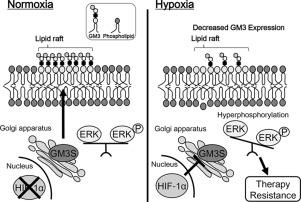Biochimica et Biophysica Acta (BBA) - General Subjects ( IF 3 ) Pub Date : 2020-08-28 , DOI: 10.1016/j.bbagen.2020.129723 Takuto Shimizu 1 , Masaki Nagane 1 , Mira Suzuki 1 , Akinori Yamauchi 1 , Kazuhiro Kato 1 , Nagako Kawashima 2 , Yuki Nemoto 3 , Takuya Maruo 3 , Yasushi Kawakami 4 , Tadashi Yamashita 1

|
Background:
Tumor hypoxia drastically changes cancer phenotypes, including angiogenesis, invasion, and cell death. Gangliosides are sialic acid-containing glycosphingolipids that are ubiquitously distributed on plasma membranes and are involved in many biological processes, such as the endoplasmic reticulum stress response and apoptosis. In this study, we investigated the regulation and function of glycosphingolipids, which associate with lipid raft on mammalian plasma membranes under hypoxic condition.
Methods:
B16F10 melanoma cells were subjected to chemical hypoxia and low pO2 condition, and the effect of hypoxia on expression of GM3 synthase were analyzed. Cellular resistance to oxidative stress was analyzed in GM3S-KO B16F10 cells.
Results:
Hypoxia treatment decreased the expression of ganglioside GM3 synthase (GM3S; ST3GAL5), which synthesizes the common substrate of ganglioside biosynthesis. RNA interference of hypoxia inducible factor 1 subunit alpha (HIF-1α) inhibited hypoxia-induced GM3S suppression. Additionally, GM3S deficiency increased cellular resistance to oxidative stress and radiation therapy via upregulation of ERK.
Conclusions:
Altered synthesis of glycosphingolipids downstream of HIF-1α signaling increased the resistance of melanoma cells to oxidative stress. Furthermore, GM3 has important role on cellular adaptive response to hypoxia.
General significance:
This study indicates that tumor hypoxia regulates therapy-resistance via modulation of ganglioside synthesis.
中文翻译:

肿瘤缺氧调节神经节苷脂GM3合酶,有助于恶性黑色素瘤的氧化应激抗性。
背景:
肿瘤缺氧会极大地改变癌症的表型,包括血管生成,侵袭和细胞死亡。神经节苷脂是含唾液酸的糖鞘脂,其普遍分布在质膜上,并参与许多生物学过程,例如内质网应激反应和细胞凋亡。在这项研究中,我们研究了在低氧条件下与鞘脂脂质筏相关的糖鞘脂的调节和功能。
方法:
将B16F10黑色素瘤细胞置于化学低氧和低pO 2条件下,分析了低氧对GM3合酶表达的影响。在GM3S-KO B16F10细胞中分析了细胞对氧化应激的抗性。
结果:
缺氧处理降低了神经节苷脂GM3合酶(GM3S; ST3GAL5)的表达,这合成了神经节苷脂生物合成的共同底物。RNA干扰缺氧诱导因子1亚基α(HIF-1α)抑制缺氧诱导的GM3S抑制。此外,GM3S缺乏症通过ERK的上调增加了细胞对氧化应激和放射疗法的抵抗力。
结论:
HIF-1α信号下游糖鞘脂合成的改变增加了黑素瘤细胞对氧化应激的抵抗力。此外,GM3在细胞对缺氧的适应性反应中具有重要作用。
一般意义:
这项研究表明,肿瘤缺氧通过调节神经节苷脂合成来调节抗药性。



























 京公网安备 11010802027423号
京公网安备 11010802027423号